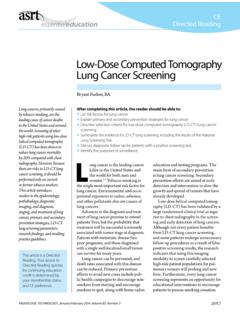Transcription of New Immunotherapies: Management of Immune …
1 New immunotherapies : Management of Immune related Adverse Events Dr. Margaret Smith General Practitioner in Oncology Dr. Margaret Smith: None Dr. Kerry Savage: Advisory Board Memberships: BMS, Merck, Seattle Genetics Grants/honorariums received: BMS, Merck, Seattle Genetics, Infinity Clinical trial participation within the past 2 years: BMS, Seattle Genetics Declaration of Conflict of Interest At the end of this workshop, participants will be able to: Describe the mechanism of action of the new immunotherapies .
2 PD-1 and CTLA-4 Immune Checkpoint Inhibition currently approved and in use in BC Describe the difference between the new immunotherapies and targeted therapies for treatment of metastatic cancer. Identify and effectively carry out surveillance of Immune - related adverse events (irAEs) and toxicities of these therapies Institute appropriate treatment and Management of irAEs associated with these therapies Objectives Actual irAEs from VICC patient cases over the past year will be discussed. Approval and use of these therapies in British Columbia is new: we are essentially in a Phase IV post marketing survey with these agents We are all learning and gaining experience with these agents as they come in to use locally: Oncologists, GPO s, support specialists: nephrologists, gastroenterology, endocrinology and more.
3 Which of the following are Immune related adverse events associated with ipilumumab: a) vitilago b) colitis c) neuropathy d) pituitary failure e) lymphadenopathy f ) all Emergence of Immune related adverse events from checkpoint inhibition may correlate with treatment response: true false unknown at this time Which of these tumors have current Canada Health Approval for use of Checkpoint Inhibition therapy: a) melanoma b) advanced stage ovarian/fallopian tube carcinoma c) advanced renal clear cell carcinoma d) pancreatic carcinoma e) advanced non-small cell lung cancer Which of the following are targeted therapies for melanoma: a) ipilimumab b) vemurafenib c) nivolumab d) pertuzumab e) dabrafenib/trametinib First Things First.
4 Basic Immunology to Understand Checkpoint Inhibition Thanks to various contributors for graphics on T Cell Immune Theory T cells are thought to play an important role in Immune surveillance and tumor destruction. Immune response regulation is built into our T cell Immune system to prevent bystander tissue damage Cytokines, T reg cells, and cosignalling molecules are some of the mechanisms that limit the strength and extent of the activated T cell s Immune response T cell therapy How Do T-cells Recognize and Kill Tumour Cells?
5 Tumours express tumour-associated antigens1,2 Antigen 1. Mellman I. Nature. 2011;480:480-89; 2. Heemskerk B. EMBO J. 2013;32(2):194-203. Antigen presenting cell (APC) captures tumour-associated antigens2 APC presents the tumour-associated antigen to an inactive T-cell, along with a co-stimulatory signal2 Co-stimulatory signal Antigen Cytotoxic T-cell induces tumour cell death by apoptosis1,2 Inactive T-cell T-cell becomes activated and binds to tumour cell Cytotoxic T-cell 12 There are many potential sites for checkpoint receptor inhibition Tumour Immune suppression Tumour cells can escape from Immune system destruction through many mechanisms.
6 Including the expression of Immune suppressive molecules on their cell surface Tumour Cells PD-L1 Tumour Antigen Mellman et al. Nature. 2011;480:480-9. 16 Tumour Immunosuppression Mellman et al. Nature. 2011;480:480-9. Tumour cells can escape from Immune system destruction through many mechanisms, including the expression of Immune suppressive molecules on their cell surface 1. Activated T-cells Activated T-cells go to tumour site Able to recognize and destroy tumour cells Have PD-1 on their surface Tumour Cells PD-1 PD-L1 Tumour Antigen 17 Tumour Immunosuppression Mellman et al.
7 Nature. 2011;480:480-9. Tumour cells can escape from Immune system destruction through many mechanisms, including the expression of Immune suppressive molecules on their cell surface 2. PD-1 on T-cells binds to PD-L1 on tumour cells Tumour Cells PD-1 1. Activated T-cells Activated T-cells go to tumour site Able to recognize and destroy tumour cells Have PD-1 on their surface PD-1 PD-L1 18 Tumour Immunosuppression Mellman et al. Nature. 2011;480:480-9. Tumour cells can escape from Immune system destruction through many mechanisms, including the expression of Immune suppressive molecules on their cell surface 2.
8 PD-1 on T-cells binds to PD-L1 on tumour cells 3. T-cells are inactivated = Immunosuppression Tumour Cells PD-1 1. Activated T-cells Activated T-cells go to tumour site Able to recognize and destroy tumour cells Have PD-1 on their surface PD-1 PD-L1 19 How Does Anti-PD-1/PD-L1 Therapy Work? Mellman et al. Nature. 2011;480:480-9. Tumour Cells PD-1 PD-L1 Anti-PD-1 or Anti-PD-L1 Antibody Anti-PD-1 or anti-PD-L1 antibody therapy blocks the interaction between PD-1 and PD-L1 20 CTLA-4 regulation occurs centrally in the lymph node where there is initial response to the tumor antigen PD-1 regulation and response occurs in the peripheral tissues where it binds to PD-1 ligand, which is overexpressed on some tumour cells CTLA4 and PD-1 are Immune checkpoint inhibitors CTLA4: cytotoxic T-lymphocyte-associated antigen 4.
9 DC: dendritic cell; MHC: major histocompatibility complex; PD-1: programmed cell death protein-1; TCR: t-cell recptor. Pardoll DM. ;12:252-64. Immune checkpoint inhibitors maintain self-tolerance and modulate the duration and amplitude of Immune responses CTLA4 regulates initial response to antigen PD-1 regulates response in tissues Major Role 22 Examples of targeted therapy receptors: BRAF (vemurafenib) VEGF (bevacizumab) HER2 (trastuzumab) PDGFR (sorafenib, sunitinib) KRAS (panitumumab) Targeted Immune Therapies are different from Checkpoint Inhibition Therapies Why all the interest in Checkpoint Inhibitor Immune Therapies?
10 They bring new hope of effective treatments in tumor sites that previously had little or no success with systemic therapies NEJM May 21, 2015 Michael A Postow et al Untreated Melanoma NEJM Nov 5, 2015 Nivolumab vs everolimus in metastatic renal cell cancer NEJM Nov 5 2015 Motzer et al 010203040506070809010003691215182124 Nivolumab CheckMate 017: PFS in advanced non small cell lung cancer Brahmer et al, NEJM May 21, 2015 CI: confidence interval; HR: hazard ratio; PFS: progression-free survival. Brahmer et al.
















